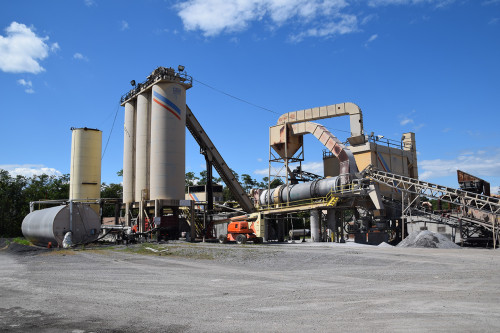Boost the Feel And Look of Your Home with Expert Commercial Parking Whole Lot Paving
Boost the Feel And Look of Your Home with Expert Commercial Parking Whole Lot Paving
Blog Article
Unlocking the Tricks of Warm Mix Asphalt Technology
Checking out the depths of hot mix asphalt technology uncovers a globe where careful procedures and precise formulations assemble to shape our roads and framework. The combination of fillers, aggregates, and binders isn't simply a building task but a critical orchestration of sturdiness and efficiency.
Significance of Hot Mix Asphalt
Warm Mix Asphalt plays an essential function in contemporary framework growth due to its toughness and cost-effectiveness. As the most frequently utilized paving material for roadways, highways, and car park whole lots, Warm Mix Asphalt provides a range of benefits that add to its significance in building jobs.
The longevity of Warm Mix Asphalt stems from its composition, which consists of accumulations, binder, and filler products that are carefully chosen and mixed to satisfy details performance requirements. On the whole, the relevance of Warm Mix Asphalt in infrastructure development can not be understated, as it continues to be a foundation of modern construction techniques.
Elements of Asphalt Mixes
The composition of asphalt mixes contains meticulously chosen accumulations, binder, and filler products that are important for accomplishing details performance demands. Aggregates are the primary component of asphalt mixes, offering strength and security. These accumulations can be natural, such as gravel or smashed stone, or synthetic, like recycled products from old sidewalks. The binder, typically bitumen or asphalt concrete, holds the accumulations together and supplies versatility and longevity to the mix. The choice of the binder is important as it straight affects the mix's efficiency in various weather. Fillers, such as moisturized lime or Portland concrete, are made use of to improve the mix's workability and aging resistance. Angled Parking.
The combination and percentage of these components play a substantial duty in determining the quality and efficiency of the asphalt mix. Designers very carefully create the mix to fulfill particular demands, taking into consideration variables like traffic volume, environment conditions, and sidewalk life-span. Correct selection and balancing of accumulations, binder, and fillers are important for developing long lasting, lasting asphalt pavements.
Mixing and Manufacturing Techniques

When the accumulations are picked, the binder, commonly asphalt cement, is included to bind the products together. The binder's top quality and quantity dramatically affect the mix's strength, versatility, and resistance to environmental aspects. Furthermore, fillers like hydrated lime or Portland concrete might be incorporated to boost particular features hot mix asphalt of the asphalt mix, such as its workability or dampness resistance.
During production, the accumulations and binder are warmed, typically in between 250-325 ° F(121-163 ° C ), to promote mixing and ensure proper layer of the accumulations. The mixing process must be detailed to accomplish an uniform combination that advertises the preferred efficiency features of the asphalt. Various methods, such as set blending or drum blending, are utilized to attain constant and top quality asphalt blends for building tasks.
Factors Impacting Asphalt Performance
Elements influencing asphalt efficiency include a range of variables that influence the sturdiness, long life, and total top quality of asphalt sidewalks. One vital variable is the top quality of materials used in the asphalt mix.

Layout factors to consider, such as sidewalk density and drainage, are vital in making sure the long-lasting efficiency of the asphalt pavement. By thoroughly thinking about these engineers, variables and service providers can maximize asphalt performance and improve the service life of sidewalks.
Sustainable Practices in Asphalt Innovation

WMA enables for the manufacturing and positioning of asphalt mixes at reduced temperatures contrasted to typical hot-mix asphalt, resulting in lowered power intake and greenhouse gas emissions. The use of permeable asphalt blends can aid mitigate stormwater overflow issues by enabling water to infiltrate via the pavement and right into the ground, advertising natural water filtering and reenergize procedures.
Conclusion
To conclude, warm mix asphalt innovation plays a critical function in modern-day facilities advancement due to its toughness and cost-effectiveness. By thoroughly balancing parts, using proper mixing techniques, and thinking about various elements, engineers can produce high-quality asphalt blends that withstand rush hour lots and harsh climate condition. Welcoming sustainable methods, such as using warm-mix innovations and recycled materials, additionally boosts the ecological kindness of asphalt modern technology.
Blending and production methods in hot mix asphalt technology involve the precise mix and processing of aggregates, binder, and fillers to create a durable and high-performance asphalt mix.Elements influencing asphalt performance include a variety of variables that impact the resilience, long life, and overall high quality of asphalt pavements. Sustainable methods in asphalt innovation encompass various efforts aimed at lowering the ecological influence of asphalt production and paving processes. By including recovered asphalt sidewalk (RAP) and recycled asphalt roof shingles (RAS) right into new asphalt mixes, the market can dramatically minimize the intake of raw materials and energy, while likewise reducing land fill waste.
WMA permits for the manufacturing and positioning of asphalt mixes at reduced temperatures contrasted to conventional hot-mix asphalt, resulting in lowered energy usage and greenhouse gas exhausts.
Report this page